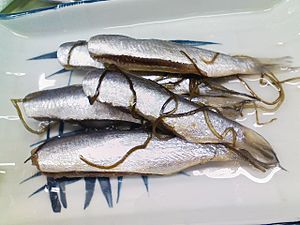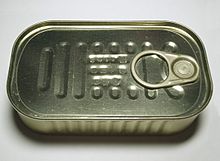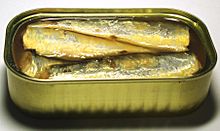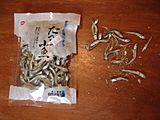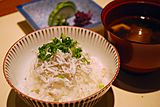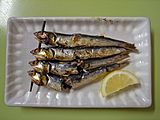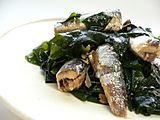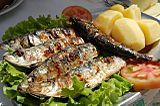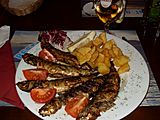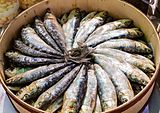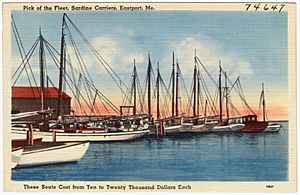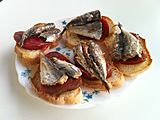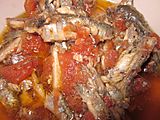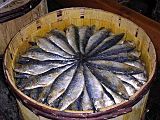Sardines as food facts for kids
Sardines are small, oily fish packed with nutrients. People eat them all over the world. Larger fish, seabirds, and marine mammals also eat sardines. These fish are a great source of omega-3 fatty acids, which are good for your health. You can often find sardines in cans. But you can also eat them grilled, pickled, or smoked when they are fresh.
The word sardine first appeared in English in the early 1400s. It might come from the island of Sardinia in the Mediterranean Sea. Sardines were once very common around that island. Sardines are related to herrings. Both belong to the same fish family, called Clupeidae.
The names sardine and pilchard can be a bit confusing. What they mean often depends on where you are. For example, in the United Kingdom, young pilchards are called sardines. Some people say fish shorter than 6 inches (15 cm) are sardines. Fish longer than that are called pilchards. The FAO and WHO list 21 types of fish that can be called sardines when canned.
People catch sardines for many reasons. They are used as bait for other fish. They are also eaten fresh, canned, dried, salted, or smoked. Sometimes, they are turned into fish meal for animal feed. Sardine oil is used to make things like paint and varnish. But mostly, sardines are caught for people to eat.
Contents
Healthy Bites: Sardine Nutrition
| Nutritional value per 100 g (3.5 oz) | |
|---|---|
| Energy | 185 kcal (770 kJ) |
|
0.54 g
|
|
| Sugars | 0.43 g |
| Dietary fiber | 0.1 g |
|
10.45 g
|
|
| Saturated | 2.684 g |
| Monounsaturated | 4.818 g |
| Polyunsaturated
omega‑6
|
2.111 g
1.457 g
0.655 g
|
|
Protein
|
20.86 g
|
| Vitamins | Quantity
%DV†
|
| Vitamin A equiv. |
4%
34 μg |
| Thiamine (B1) |
4%
0.044 mg |
| Riboflavin (B2) |
19%
0.233 mg |
| Niacin (B3) |
26%
4.2 mg |
| Pantothenic acid (B5) |
15%
0.73 mg |
| Vitamin B6 |
9%
0.123 mg |
| Folate (B9) |
6%
24 μg |
| Vitamin B12 |
375%
9 μg |
| Choline |
16%
76 mg |
| Vitamin C |
1%
1 mg |
| Vitamin D |
32%
4.8 μg |
| Vitamin E |
9%
1.38 mg |
| Vitamin K |
0%
0.4 μg |
| Minerals | Quantity
%DV†
|
| Calcium |
24%
240 mg |
| Copper |
14%
0.272 mg |
| Iron |
18%
2.3 mg |
| Magnesium |
10%
34 mg |
| Manganese |
10%
0.206 mg |
| Phosphorus |
52%
366 mg |
| Potassium |
11%
341 mg |
| Selenium |
58%
40.6 μg |
| Sodium |
28%
414 mg |
| Zinc |
15%
1.4 mg |
| Other constituents | Quantity |
| Water | 66.86 g |
| Cholesterol | 61 mg |
|
Link to USDA database entry
|
|
| †Percentages estimated using US recommendations for adults. | |
Sardines are full of vitamins and minerals. Eating a small serving of sardines daily can give you lots of important nutrients. For example, they provide about 13% of your daily vitamin B2. They also give you about a quarter of your daily niacin. Plus, they offer about 150% of your daily vitamin B12.
All B vitamins help your nervous system work well. They also help your body turn food into energy. Sardines are also rich in important minerals like phosphorus, calcium, and potassium. They also have trace minerals like iron and selenium.
Sardines are a natural source of marine omega-3 fatty acids. These healthy fats can help reduce the risk of heart problems. Some studies even suggest that eating omega-3s regularly can boost brain function. They might also help lower blood sugar a little. Sardines are also a good source of vitamin D, calcium, and protein.
Because sardines are low on the food chain, they have very low levels of harmful substances. For example, they have much less mercury than many other fish people eat. This makes them a very safe and healthy choice.
Sardines in a Can
Sardines are canned in many different ways. First, the fish are washed. Then, their heads are removed. After that, they are smoked or cooked. They can be deep-fried or steamed. Then, the fish are dried.
Finally, they are packed into cans. They might be in olive, sunflower, or soybean oil. Sometimes they are in water. Other times, they are packed in tomato, chili, or mustard sauce.
The fish in sardine cans might sometimes be other small fish. For example, they could be sprat or round herrings. The size of the fish can vary by species. Good quality canned sardines should have their heads and gills removed. Larger types might also have their insides removed. If not, the live fish are kept in tanks to clean out their digestive systems.
Sardines are usually packed very tightly in small cans. These cans often have a pull tab for easy opening. Sometimes, they have a special key attached. This makes them easy to carry. They also last a long time and are a ready-to-eat food.
The way sardines are packed tightly in cans led to the saying, "packed like sardines." This phrase describes any place where people or things are crowded together. Think of a busy bus or a crowded nightclub. It's also the name of a children's game. In this game, one person hides. Everyone who finds them then hides in the same spot. This continues until only one person is left to find the group.
Sardines Around the World
Australia
Australia has a sardine fishery that catches a species called Sardinops sagax. These fish live in temperate waters. They are found from close to shore to about 200 meters deep. This area stretches from Hervey Bay to Shark Bay.
Some of these sardines are sold fresh for people to eat. Others are processed into canned pet food. But more and more, they are used to feed Southern bluefin tuna kept in sea cages.
Canada
The last sardine packing plant in North America is in Blacks Harbour, New Brunswick. The Brunswick brand started in the 1880s. They make sardines, which are actually young herring. Brunswick says it is the biggest sardine producer in the world.
England
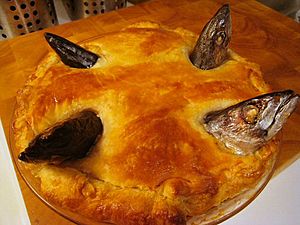
Pilchard fishing was a big industry in Cornwall from about 1750 to 1880. After that, it almost disappeared. But by 2007, fish stocks were getting better. Since 1997, sardines from Cornwall have been sold as "Cornish sardines." Since 2010, they have special protection under EU law. This means only sardines from Cornwall can use that name. A traditional Cornish dish is stargazy pie. It's a pie with pilchards baked inside.
Croatia
People have fished for sardines (called sardela or sardina) on the coasts of Dalmatia and Istria for thousands of years. This region was part of the Roman Empire and later ruled by Venice. Fishing, especially for sardines, has always been important here. Many towns along the coast celebrate fishing with old-style boats.
Today, factories still can sardines in Croatia. There are four main factories in Rovinj, Zadar, Postira, and Sali. Sali's factory started in 1905. Many famous dishes are made with sardines. These include komiška pogača (a pie with salted sardines and tomato sauce). Another is saur or inšavor (fried sardines seasoned with olive oil, vinegar, and garlic).
France
Sardine fishing and canning is a traditional industry in Brittany, France. Most French canneries are still there. This area is known as the place where sardine canning was invented. Douarnenez was the world's top sardine exporter in the 1800s.
In France, sardines are traditionally fried, dried, and then canned. This old process is called préparées à l'ancienne. In most other countries, sardines are steam-cooked after being canned.
Greece
Small oily fish like sardines have been a key part of the Greek diet for a very long time. They are popular in summer, especially in July and August. Sardines are praised as a healthy food with lots of protein and Omega-3 fatty acids.
Greeks mostly eat sardines grilled with lemon and garlic. They also cure them in salt and olive oil (called pastés). Both dishes are common in seaside "taverna" restaurants. They are also served as a snack (meze) often with ouzo.
The island of Lesvos is famous for its sardines. A special kind of sardine called papalina lives in Kalloni Bay there. Lesvos also has a long tradition of making ouzo. Some companies on Lesvos produce and export canned sardines. These are seen as a local treat.
"Sardine festivals" are held in summer on Lesvos and in other Greek fishing towns. These festivals celebrate traditional life and music. They also offer lots of fish to eat.
India
Sardines are a favorite food for people in Kerala, Andhra Pradesh, Tamil Nadu, and coastal Karnataka. People usually eat the fish fresh. Canned sardines are not as popular. Fried sardines are a very popular dish.
They are called mathi or chāla in Kerala and Tamil Nadu. In Andhra Pradesh, they are called kavallu. In West Bengal, they are khoira. People in coastal Karnataka call them pedvo or bhootai. Sardines are cheaper in India than bigger fish like seer or pomfret. This makes them an affordable treat. They are eaten in many ways, including deep-fried, pan-fried, or in curries.
Italy
Italy is close to Sardinia, so both northern and southern Italy have dishes with sardines. Sicily's regional dish is pasta con le sarde. This is a pasta dish with sardines, fennel seed, saffron, raisins, and garlic. It also has onion, olive oil, white wine, lemon juice, and tomato. It's topped with toasted breadcrumbs and crushed almonds.
In Venice, sardines in saor is an appetizer. It has sardine steaks marinated in white wine, raisins, and vinegar. The sardines are then floured and fried in olive oil. They are garnished with parsley, onions, crushed almonds, and raisins.
Japan
-
Dried niboshi (sardines) used in Japanese cooking
- See also Tatami iwashi
Morocco
Morocco is the biggest exporter of canned sardines in the world. They are also the main supplier of sardines to Europe. Sardines make up more than 62% of Morocco's fish catch. They account for 91% of the raw material used in their canning industry. About 600,000 tonnes of fresh sardines are processed each year. Famous Moroccan recipes include fried stuffed sardines and sardine balls in spicy tomato sauce.
Norway
For a long time, sardine canning was the main business in the city of Stavanger. This was before oil fields were found in the fishing areas. Today, only a sardine museum remains among the oil refineries in Stavanger.
Peru
Peru has a long history of people eating Engraulis ringens and other sardines. This goes back to ancient cultures like Chimú and Caral-Supe civilization. The Caral-Supe civilization, the oldest known in the Americas, relied almost completely on eating E. ringens.
However, since the 1950s, most of the E. ringens caught (also called anchoveta or Peruvian sardine) have been used to make fishmeal and fish oil. Only a tiny amount is eaten directly by people. In recent years, direct human consumption has increased. This is due to efforts to promote health and economic benefits.
Portugal
Sardines are very important in Portuguese cuisine and culture. Portuguese people have always depended on the sea for food and trade. They love fish, especially during their popular festivals. The most important festival is Saint Anthony's day on June 13. This is Lisbon's biggest festival. Grilled sardines are the favorite snack.
Almost everywhere in Portugal, from Figueira da Foz to Olhão, people have a summer tradition. They eat grilled sardines (sardinhas assadas).
Spain
In the Timanfaya Volcanic National Park on Lanzarote in the Canary Islands, there's a fun snack for tourists. They grill freshly caught sardines over the heat from a volcano! On Spain's Atlantic coast, fried sardines are often served as tapas with drinks. They can also be the first course of a meal. On the Mediterranean coast, grilling sardines is more common.
Turkey
Sardines (called sardalya in Turkish) are a special food in Turkish cooking. You can find them easily in fish markets along Turkey's western coasts. They are usually grilled or steamed in ovens. They are often served as a main dish with alcoholic drinks, especially rakı.
In the Gallipoli peninsula and the Aegean region, sardines are oven-cooked wrapped in grape leaves. They are also canned in factories in coastal cities. These cities include İstanbul, Gelibolu, Çanakkale, and Trabzon.
United States
In the United States, the sardine canning industry was biggest in the 1950s. Since then, it has become smaller. The last large sardine cannery in the U.S. was the Stinson Seafood plant in Prospect Harbor, Maine. It closed on April 15, 2010, after 135 years. During the COVID-19 pandemic, sardines and other canned fish became popular again. New small companies even started making them.


